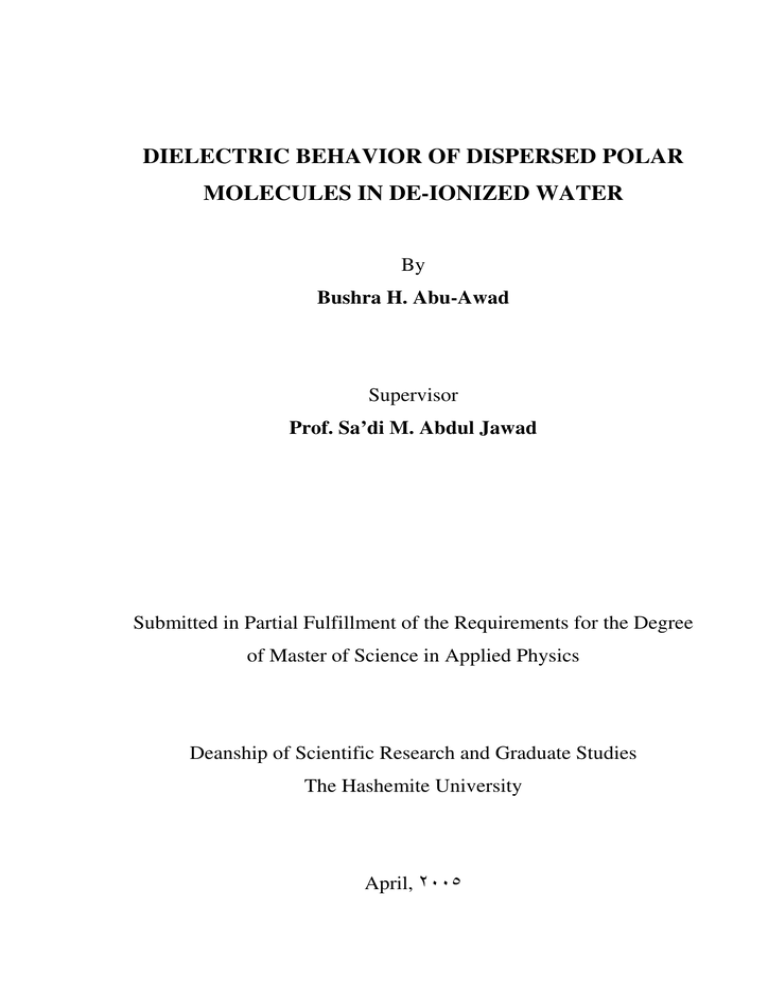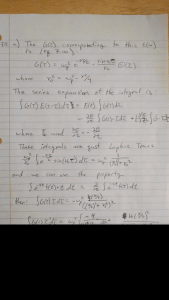Dielectric behavior of dispersed polar molecu
advertisement

DIELECTRIC BEHAVIOR OF DISPERSED POLAR MOLECULES IN DE-IONIZED WATER By Bushra H. Abu-Awad Supervisor Prof. Sa’di M. Abdul Jawad Submitted in Partial Fulfillment of the Requirements for the Degree of Master of Science in Applied Physics Deanship of Scientific Research and Graduate Studies The Hashemite University April, ٢٠٠٥ ii This thesis was successfully defended and approved on (٧ / ٤/ ٢٠٠٥). Examination Committee Dr. Sa’di Abdul Jawad / (Chairman) Prof. of Materials Science. Signature ---------------- Dr. Awni Hallak / (Member) Prof. of Condensed Matter. ----------------- Dr. Hayel Shehadeh / (Member) Asst. Prof. of Condensed Matter. ---------------- Dr. Riyad Bitar / (Member) Prof. of Condensed Matter. ---------------- iii DEDICATION TO MY PARENTS TO MY SISTER AND BROTHERS TO MY CHILDHOOD FRIENDS LORA, DINA AND WAFA’A iv ACKNOWLEDGMENT I am greatly indebted to my supervisor: Professor Sa’di Abdul Jawad for his continuous encouragement and cooperation throughout the course of this research. Special thanks go to Dr. H. M. El-Ghanem from The University of Science and Technology for providing samples for this research. I wish also to thank my friends Noor Al-Awwad, Lowana Barghothi and Mais Momani for their encouragement. Finally, deep gratitude goes to my family for their financial and moral support. Bushra Abu-Awad v LIST OF CONTENTS Page Committee Decision ii Dedication iii Acknowledgment iv List of Contents v List of Tables viii List of Figures ix Abstract in English xv Chapter One: Introduction ١ ١١ Dispersed particles ٢ ١٢ De-ionized water ٤ ١٣ Interaction between particles ٥ ١٤ Previous studies ١١ ١٥ Current studies ١٣ Chapter Two: Theoretical Background ١٥ ٢١ Equivalent Electric Circuit ١٦ ٢١١ Impedance ١٦ ٢١٢ Series Connection ٢٣ ٢١٣ Parallel Connection ٢٥ vi ٢١٤ Two RC networks in parallel ٢٦ ٢١٥ RC circuit with a resistor in series ٢٩ ٢١٦ RC circuit with two resistors in series ٣١ ٢٢ Impedance-Dielectric Properties Correlation ٣٢ ٢٣ Relaxation in Electrical Circuits ٣٥ ٢٤ Dielectric with a Single Relaxation Time ٤١ ٢٤١ Macroscopic Derivation of the Debye Equation ٤١ ٢٤٢ The effect of Temperature ٤٦ ٢٤٣ Methods of Displaying Relaxation Peaks ٤٧ ٢٥ Dielectric Polarization ٤٩ ٢٥١ Basic Principle ٤٩ ٢٥٢ Polarization of polar molecules ٥٠ ٢٥٣ Orientation of dipoles in an electric field ٥٠ ٢٦ Dipolar Interaction ٢٦١ Dipolar Molecules in Dilute Solutions ٥٤ ٥٥ Chapter Three: Experimental Part ٦٠ ٣١ Materials ٦١ ٣٢ Impedance Measurements ٦١ ٣٢١ The ١٢٦٠ Impedance/Gain Analyzer ٦٢ ٣٢٢ The ١٢٩٤ Impedance Interface ٦٧ vii ٣٢٣ Impedance Measurement Software ٦٧ Chapter Four: Results and Discussion ٦٨ ٤١ Equivalent Circuits ٦٩ ٤١١ Impedance Analysis ٧٠ ٤١٢ Electric Modulus ٧٥ ٤١٣ Admittance Analysis ٧٩ ٤١٤ Dielectric Permittivity Analysis ٨٢ ٤٢ Dielectric Behavior of Dispersed Polar Molecules in De-Ionized Water ٨٦ ٤٢١ Impedance ٨٧ ٤٢٢ Permittivity ١٠٦ ٤٢٣ Electric Modulus ١١٧ ٤٢٤ Activation Energy ١٢٥ Chapter Five: Conclusions and Recommendations ١٣٠ ٥١ Conclusions ١٣١ ٥٢ Recommendations ١٣٢ Chapter Six: References ١٣٣ Abstract in Arabic ١٣٨ viii LIST OF TABLES Table No. Title Page ٢١ Common Electrical Elements. ٢١ ٣١ Materials properties. ٦١ ٤١ Average molecular separation for ٩٢ different concentrations. ٤٢ Conductivity at concentration about ١٠١ ٠٠٣M/L. ٤٣ Relaxation times at concentration ١٠٥ about 8.5 x10 −3 M / L . ٤٤ Relaxation times for Sodium Benzoate. ١٠٥ ٤٥ Activation energy. ١٢٥ ix LIST OF FIGURES Figure No. Title Page ٢١ Sinusoidal current response in a linear system. ١٧ ٢٢ Nyquist plot with impedance vector. ١٩ ٢٣ Simple equivalent circuit with one time constant. ٢٠ ٢٤ Bode plot with one time constant. ٢١ ٢٥ Series connection for a resistor and a capacitor. ٢٣ ٢٦ Parallel connection for a resistor and a capacitor. ٢٥ ٢٧ Two RC networks in parallel. ٢٦ ٢٨ RC with a resistor in series. ٢٩ ٢٩ RC with two resistors. ٣١ ٢١٠ Series connection for a resistor and a capacitor. ٣٦ ٢١١ Charge, current and voltage represented in the ٣٨ complex plane. ٢١٢ Parallel connection for a resistor and a capacitor. ٣٩ a) A capacitor in vacuum. b) A capacitor filled ٢١٣ with a dielectric. ٤٢ x Figure No. Title Page a. The real part of complex dielectric constant as a ٢١٤ function of log ωτ for a dielectric. b.The imaginary ٤٥ part of ε * for the same dielectric. ٢١٥ ٢١٦ Arc plot for a Debye dielectric. The orientation of a dipole moment (٢aq) in a ٤٨ ٥١ presence of an electric field E. ٣١ Impedance measurement system. ٦٢ ٣٢ ١٢٦٠ Impedance/Gain-Phase Analyzer. ٦٣ ٣٣ The three FRA signals. ٦٤ ٣٤ Circuit for charge amplifier-FRA setup. ٦٥ ٤١ Real (Z`) and imaginary (Z``) components of ac impedance ٧١ versus frequency for RC circuits. ٤٢ Real (Z`) versus imaginary (Z``) components of ac ٧٤ impedance for RC circuits. ٤٣ Real (M`) and imaginary (M``) of electric modulus versus ٧٧ frequency for RC circuits. ٤٤ Real (M`) versus imaginary (M``) components of ac electric modulus for RC circuits. ٧٨ xi Figure No. Title Page ٤٥ Real (Y`) and imaginary (Y``) components of ac ٨٠ admittance versus frequency for RC circuits. ٤٦ Real (Y`) versus imaginary (Y``) components of ac ٨١ admittance for RC circuits. ٤٧ Dielectric relative permittivity (ε`) and dielectric ٨٣ loss (ε``) versus frequency for RC circuits. ٤٨ Dielectric permittivity ( ε`) versus dielectric loss ٨٤ (ε`) for RC circuits. ٤٩ The logarith of the dielectric relative permittivity ٨٥ (ε`) and dielectric loss (ε``) versus frequency for RC circuits. Real component ( Z ′ ) versus frequency for (a) Ketrolac (low concentration), (b) Ketrolac (high concentration), (c) Sod. Lauryl.SO٤, (d) Na٤١٠ Salicylate, (e) Sodium Benzoate and (f) Sodium Chloride. ٨٩ xii Figure No. Title Page Imaginary component ( Z ′′ ) versus frequency for (a) ٤١١ Ketrolac (low concentration), (b) Ketrolac (high ٩٣ concentration), (c) Sod. Lauryl.SO٤, (d) NaSalicylate, (e) Sodium Benzoate and (f) Sodium Chloride. Real component ( Z ′ ) versus imaginary component ٤١٢ ( Z ′′ ) for (a) Ketrolac (low concentration), (b) ٩٨ Ketrolac (high concentration), (c) Sod. Lauryl.SO٤, (d) Na-Salicylate, (e) Sodium Benzoate and (f) Sodium Chloride. Conductivity versus concentration for (a) Ketrolac ٤١٣ (b) Sod. Lauryl.SO٤, (c) Na-Salicylate, (d) Sodium ١٠٢ Benzoate and (e) Sodium Chloride. Real component of permittivity ( ε ′ ) versus frequency for (a) Ketrolac (low concentration), (b) Ketrolac (high concentration), (c) Sod. Lauryl.SO٤, ٤١٤ (d) Na-Salicylate, (e) Sodium Benzoate and (f) Sodium Chloride. ١٠٧ xiii Figure No. Title Page Imaginary component ( ε ′′ ) versus frequency for (a) ٤١٥ Ketrolac (low concentration), (b) Ketrolac (high ١١١ concentration), (c) Sod. Lauryl.SO٤, (d) Na-Salicylate, (e) Sodium Benzoate and (f) Sodium Chloride. Logarithm ( ε ′′ ) versus frequency for (a) Ketrolac ٤١٦ (low concentration), (b) Ketrolac (high frequency), ١١٤ (c) Sod. Lauryl.SO٤, (d) Na-Salicylate, (e) Sodium Benzoate and (f) Sodium Chloride. Real component of electric modulus ( M ′ ) versus ٤١٧ frequency for (a) Ketrolac (low concentration), (b) ١١٩ Ketrolac (high concentration), (c) Sod. Lauryl.SO٤, (d) Na-Salicylate, (e) Sodium Benzoate and (f) Sodium Chloride. Imaginary component of electric modulus ( M ′′ ) ٤١٨ versus frequency for (a) Ketrolac (low concentration), (b) Ketrolac (high concentration), (c) Sod. Lauryl.SO٤, (d) Na-Salicylate, (e) Sodium Benzoate and (f) Sodium Chloride. ١٢٢ xiv Figure No. Title ln σ ٤١٩ Page Versus ١/T for (a) Ketrolac, (b) Sod. Lauryl.SO٤, (c) Na-Salicylate, (d) Sodium Benzoate and (e) Sodium Chloride. ١٢٧ xv Abstract DIELECTRIC BEHAVIOR OF DISPERSED POLAR MOLECULES IN DE-IONIZED WATER By Bushra H. Abu-Awad Supervisor Prof. Sa’di M. Abdul Jawad The dielectric behavior of polar molecules dispersed in de- ionized water was measured at room temperature in the frequency range ١ Hz to ١٠٦ Hz, for five polar molecules materials. The real and imaginary components of complex dielectric permittivity, loss factor, electric modulus and admittance were determined from the measurements of ac impedance. For certain concentration of each polar molecule the measurements were performed in the temperature range ٢٥ ٠ C up to ٨٠ ٠ C in order to calculate the activation energy from the plot of log conductivity versus temperature. Dielectric behavior of different RC circuits was performed and employed in the interpretation of dielectric behavior of dispersed polar molecules in deionized water. The effect of H-bonds and the interactions between the polar molecules and water molecules were discussed. ١٣٦ • Hogan, M. J., Brinkman, A. W. and Hashemi, T. ١٩٩٨. Humiditydependent impedance in porous spinel nickel germinate ceramic. Applied Physics. ٧٢:٢٣. • Hunter, R. J. ١٩٧٨. Foundation of Colloid Science. Oxford, Publication, New York. • Hutchison, T.S. and Baird, D.C. ١٩٦٨. The Physics of Engineering Solids. ٢nd edition. John Wiley and Sons, Inc., London, New York, Sydney. • Key, F. S. and Mass, G. ٢٠٠١. Ions, Atoms and Charged Particles, Silver Colloids ٧. • Luc Belloni. ٢٠٠٠. Colloidal interactions. Physics Condens Matter. • Macdonald, J.R. ١٩٨٧. Impedance Spectroscopy. John Wiley and Sons, Inc., New York. • Manciu, M. and Ruckenstin, E. ٢٠٠١. Role of Hydrogen Force in the Stability of Colloids at High Ionic Strengths. Langmiu. ١٧:٧٠٦١. • Margolis, J. M. ١٩٨٩. Conductive Polymers and Plastics Handbook. Chapman and Hall, New York. • Mccrum, N. G., Read, B.E. and Williams, G. ١٩٦٧. Anelastic and Dielectric Effects in Polymeric Solids. John Wiley and Sons, Inc., London, New York, Sydney. ١٣٧ • Radhakrishnan, S. and Deshpande, S.D. ٢٠٠٠. Electrical properties of conducting polypyrrole films functionalized with phthalocyanine. Materials. ٤٨:١٤٤. • Raghavan, S.R., Hou, J., Baker, G.L. and Khan, S. A., ٢٠٠٢. Colloidal interaction between particles with Tethered Non-polar chains Dispersed in Polar media. Langmuir. ١٦:١٠٦٦. • Rejon, L., Garcia, L. and Manero, O. ٢٠٠٢. Rheological and Dielectric characterization of electrological fluids. International J of Modern Physics B. ١٦:١٧. • Russel, W. B., Saville, D.A. and Wcowalter, W.R. ١٩٨٩. Colloidal dispersions. Cambridge University Press, New York. • Scherbel, J., Nguyen, P.H., Paasch, G., Brütting, W. and Schwoerer, M. ١٩٩٨. Temperature dependent broadband impedance spectroscopy on poly-(p-phenylene-vinylene) light-emitting diodes. Applied physics, ٨٣:١٠. • Solarton analytical, A Division of Solarton group Ltd. ١٢٦٠ Impedance/Gain-phase Analyzer, operating manual, UK, ٢٠٠١. • Solarton analytical, A Division of Solarton Group Ltd. ١٢٩٤ impedance Interface, operating manual, UK, ٢٠٠١. • Tareev, B. ١٩٧٩. Physics of Dielectric Materials. ٢nd edition. Mir Publishers, Moscow. ١٣٨ • Tobolsky, A. ١٩٦٠. Properties and Structure of Polymers. John Wiley and Sons, Inc., New York. • Tombari, E. Salvetti, G. and Johari, G.P., ٢٠٠٠. The temperature and polymerization effects on the relaxation time and Conductivity, and the evolution of the localized motion. Chemical Physics. ١١٣:١٦. • Verma, R., Crocker, J., Lubensky, T. C. and Yodh, A. G. ٢٠٠٠. Attraction between hard colloidal spheres in semi flexible polymer solutions. Macmolecules. ٣٣:١٧٧. • Verwey, E. J. and Overbeek, J. ١٩٤٨. Theory of Stability of Lyphobic Colloids. Elseveir, Amsterdam. • Vol, M. J. ٢٠٠٠. The Effect of Adsorption on the Vander Waals Interaction of Spherical Colloid Particles. Colloid. ١٢:y. • Yu, K. W. and Jones, T. K. ٢٠٠٠. Rotational Colloidal System.Comput. Physics Comm. ١٢٩:١٧٧.



